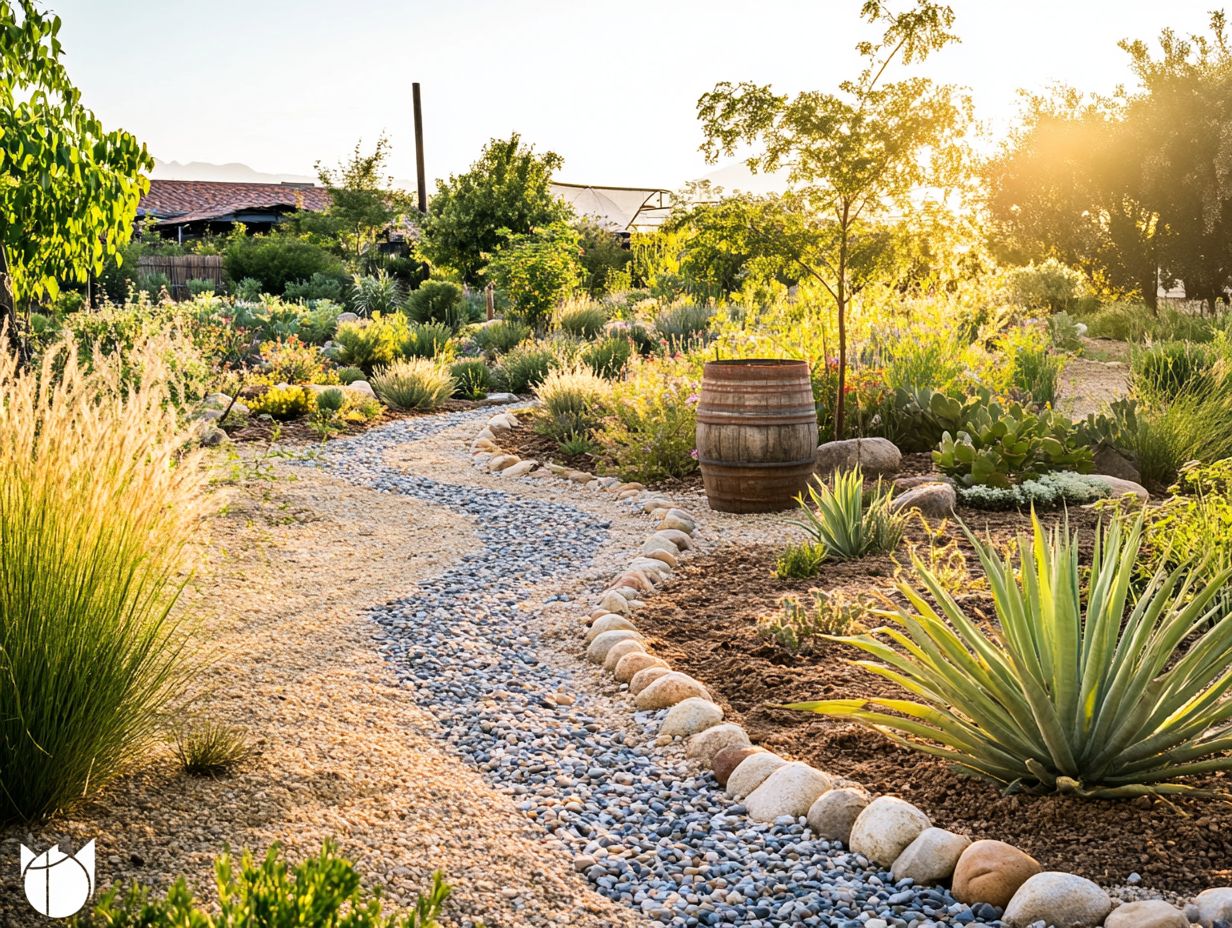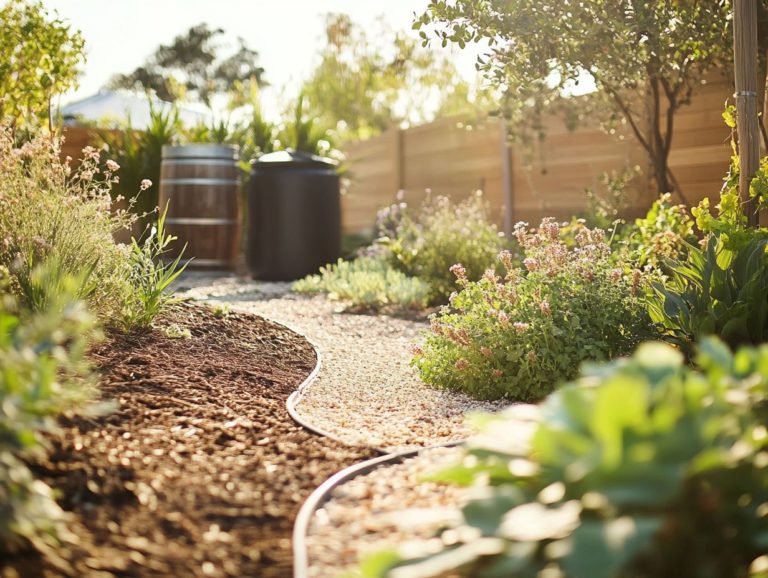Effective Drainage Solutions for Drought Gardens
In an era where water scarcity looms large, creating a drought garden demands more than merely choosing drought-resistant plants. Understanding effective garden drainage is essential.
Recognizing the significance of proper drainage can be pivotal in ensuring your garden flourishes. This discussion delves into essential drainage solutions specifically designed for drought conditions, highlighting various techniques for both surface and subsurface drainage, including storm drains and soakaways.
You ll be guided through assessing your garden’s unique requirements, implementing effective strategies, and maintaining optimal drainage for lasting success. Plus, explore alternative water management options, such as rainwater harvesting, to enrich your gardening journey in arid climates.
Immerse yourself in this knowledge and transform your garden into a resilient oasis!
Contents
- Key Takeaways:
- The Importance of Drainage in Drought Gardens
- Effective Drainage Solutions
- Assessing Your Garden’s Drainage Needs
- Implementing Drainage Solutions
- Maintaining Drainage in Drought Gardens
- Alternative Water Management Strategies
- Frequently Asked Questions
- What are some common drainage issues in drought gardens, particularly during summer storms?
- Why is effective drainage important for drought gardens?
- What are some effective drainage solutions for drought gardens?
- How can I improve drainage in my existing drought garden?
- What are some low-maintenance options for effective drainage in drought gardens, considering landscape professionals recommendations?
- When is the best time to implement effective drainage solutions for drought gardens?
Key Takeaways:

- Proper drainage is crucial for preventing waterlogging and promoting healthy plant growth in drought gardens.
- Both surface and subsurface drainage techniques can be used to effectively manage water in a drought garden.
- Regular maintenance and consideration of factors such as soil type and slope can ensure long-term effectiveness of drainage solutions in a drought garden.
The Importance of Drainage in Drought Gardens
In the realm of drought gardens, effective drainage is vital for not only nurturing healthy plant growth but also safeguarding against flooding during heavy rainfall. For tips on establishing such a garden, check out this guide on creating a sustainable drought garden. Flooding can wreak havoc on structures and lead to waterlogged soil.
As climate change increasingly disrupts weather patterns, grasping the significance of garden drainage is essential for any gardener aspiring to cultivate a flourishing outdoor space.
Implementing robust drainage systems will adeptly manage water runoff and bolster soil structure. This significantly improves erosion control and promotes optimal plant health.
Why Proper Drainage is Essential
Proper drainage is crucial for maintaining the right moisture levels in your drought gardens. It effectively prevents water accumulation, which can lead to flooding and potential safety hazards. Additionally, consider using organic treatments for drought-resistant gardens to further enhance your garden’s resilience.
An effective drainage system is not just a luxury; it s essential for promoting healthy plant growth. By ensuring that water is evenly distributed throughout your garden, these systems help mitigate the risks associated with excessive rainfall. This way, you’ll be thrilled to cultivate a resilient landscape that thrives in varied weather conditions.
By efficiently channeling away excess water, these solutions support sustainable gardening practices. They minimize the need for chemical fertilizers and reduce soil erosion, which is the wearing away of soil. Additionally, learning how to create a wildlife-friendly drought garden allows you to maintain optimal moisture levels, nurturing your lawns and garden beds while fostering biodiversity and enhancing the overall aesthetic appeal of your space.
Effective Drainage Solutions
You have a variety of drainage solutions at your disposal for your garden, each designed to tackle specific water management challenges. Options like French drains, soakaways, and permeable paving not only manage water runoff effectively but also enhance the visual appeal and functionality of your outdoor space. For those looking to create a beautiful landscape, consider exploring how to design a drought-tolerant garden.
By incorporating rain gardens and catch basins, you can significantly enhance your garden’s design while championing water conservation in the face of climate change.
Surface Drainage Techniques
Surface drainage techniques are essential for directing water runoff away from your flower beds and lawns. By utilizing methods such as drainage channels and rain gardens, you can effectively manage excess water and keep your landscape thriving.
These techniques are crucial for maintaining the health of your outdoor spaces, as they minimize the risk of erosion, which can compromise the integrity of your soil and the vitality of your plants. When designed thoughtfully, rain gardens not only absorb excess water but also facilitate the natural filtration of pollutants, making them an eco-friendly choice for homeowners like you.
Strategically placed drainage channels can redirect water flow to appropriate locations, significantly reducing the risk of flooding in vulnerable areas.
By adopting various surface drainage solutions, you not only protect your property and gardens but also contribute to broader environmental objectives by enhancing water quality and promoting sustainability.
Start transforming your garden today!
Subsurface Drainage Techniques

Subsurface drainage techniques, like French drains, are essential for elevating soil structure and drainage capacity by skillfully redirecting excess water below the surface.
Implementing these systems significantly enhances lawn aeration while fostering healthier roots. It also reduces soil compaction. By facilitating improved water movement, these drainage solutions effectively prevent waterlogging, which can suffocate plants and create harmful conditions like root rot.
Better drainage helps maintain optimal moisture levels, ultimately supporting the vitality of your plants.
With consistent drainage measures in place, you’ll cultivate lush, vibrant landscapes. Enhanced soil conditions favor nutrient absorption and promote overall plant health. Investing in these techniques pays off in aesthetics and enhances your garden’s resilience against varying weather conditions.
Assessing Your Garden’s Drainage Needs
Start by assessing your garden’s drainage needs! It’s a vital step to keep your plants flourishing. This becomes particularly important in regions where soil erosion and waterlogged conditions are common, especially in the face of changing climate patterns.
Factors to Consider
When assessing your garden’s drainage needs, consider several key factors, including soil structure, moisture levels, and any existing flooding solutions.
Understanding your soil type is fundamental. Clay-rich soils can retain too much water, while sandy soils drain rapidly, often leaving your plants thirsty. Regularly monitoring moisture levels is essential; it will help you pinpoint areas that might become waterlogged during heavy rain.
Integrating effective flooding solutions, such as swales—shallow ditches that manage water runoff—or rain gardens, enhances drainage while creating a thriving environment for your plants. Utilizing water-saving gardening techniques for drought can foster a balanced ecosystem that supports robust plant health. Ultimately, with these elements working together, your garden will flourish, even in the face of unpredictable weather patterns.
Implementing Drainage Solutions
To implement drainage solutions effectively in your garden, it s essential to have a comprehensive understanding of various options such as storm drains, French drains, and soakaways. This knowledge will help you maintain optimal plant health while enhancing the overall aesthetics of your outdoor space.
Step-by-Step Guide
Follow this step-by-step guide to install drainage solutions effectively, emphasizing techniques that promote water conservation while incorporating organic matter.
Recognizing that different environments require tailored approaches, it s vital to assess the specific needs of your garden. Start by evaluating the existing soil conditions and drainage patterns; this will guide you in selecting the most suitable drainage system.
As you embark on the installation, consider features like French drains or swales, which are excellent for diverting excess water. Don t overlook maintenance, as it s crucial for ensuring long-term functionality. Regularly inspect for blockages and clear away any debris.
By enriching your soil with organic matter, you not only enhance drainage but also nurture beneficial microorganisms that can further optimize the efficiency of your drainage systems.
Maintaining Drainage in Drought Gardens

Maintaining proper drainage in drought gardens is crucial for the health of your plants. It protects them from potential safety hazards and structural damage due to flooding. For more tips, consider how to create a drought-resistant garden, which demands a commitment to consistent care and attention, ensuring that your drainage systems remain effective over time.
By following key maintenance tips, you can create an environment where your plants thrive, even in challenging conditions.
Ready to elevate your garden’s health? Begin your drainage assessment today!
Tips for Long-Term Effectiveness
To achieve lasting effectiveness in your drainage solutions, it’s essential to focus on integrating organic matter and regularly assessing soil structure. This helps manage erosion and improve lawn care.
By consistently adding compost or well-rotted leaves into your soil, you enhance its texture and fertility. This leads to improved water retention and drainage. This proactive strategy not only combats erosion but also fosters a vibrant ecosystem that nurtures beneficial microorganisms.
Don’t forget to consider periodic soil testing to monitor the acidity of the soil and nutrient content. This ensures your soil remains healthy and structurally sound. Planting deep-rooted vegetation can further stabilize the soil, creating natural barriers against runoff. This significantly boosts the longevity and efficiency of your drainage systems.
Alternative Water Management Strategies
Exploring alternative water management strategies will transform your outdoor spaces into vibrant havens while enhancing plant health and promoting sustainability.
Techniques such as rainwater harvesting and efficient irrigation systems not only conserve resources but also contribute to a thriving garden ecosystem.
Exploring Other Options for Drought Gardens
Along with traditional drainage solutions, consider alternative options for your drought garden, such as green roofs and water features. Implementing the benefits of drip irrigation in drought gardens can enhance your sustainable gardening practices and support local wildlife.
Utilizing green roofs conserves water and provides insulation for buildings. This helps reduce energy costs and promotes a healthier urban environment. These innovative systems allow you to integrate native plant species that require minimal irrigation while creating habitats for pollinators and other beneficial insects.
Incorporating water features, like rain gardens or decorative ponds, can enhance the visual appeal of your garden. These features attract various wildlife, fostering biodiversity. Together, these elements work harmoniously to create an ecosystem that thrives even with limited resources, ultimately contributing to a more resilient landscape.
Frequently Asked Questions
What are some common drainage issues in drought gardens, particularly during summer storms?

Some common drainage issues in drought gardens include:
- Standing water
- Soil erosion
- Excessive dryness in certain areas
Why is effective drainage important for drought gardens?
Effective drainage prevents water waste, encourages healthy plant growth, and reduces the risk of plant diseases and pests.
What are some effective drainage solutions for drought gardens?
Effective drainage solutions include:
- Adding organic matter to the soil
- Creating mulched paths
- Using raised beds or containers
How can I improve drainage in my existing drought garden?
You can improve drainage by:
- Adding drainage pipes or channels
- Creating a slope in the landscape
- Using natural materials like gravel or rocks to create a dry creek bed
What are some low-maintenance options for effective drainage in drought gardens, considering landscape professionals recommendations?
Low-maintenance options include:
- Using drought-tolerant plants
- Installing a rain barrel
- Incorporating a rain garden into the landscape
When is the best time to implement effective drainage solutions for drought gardens?
The best time to implement effective drainage solutions is during the planning and design phase. However, they can also be added or improved upon at any time during the growing season.
Take action today! Implement these strategies in your garden to create a healthier, more resilient landscape.






